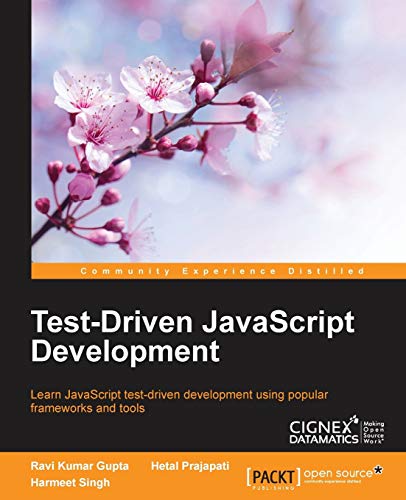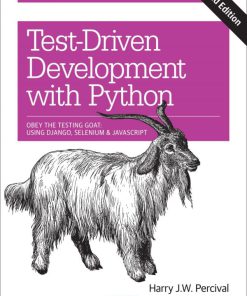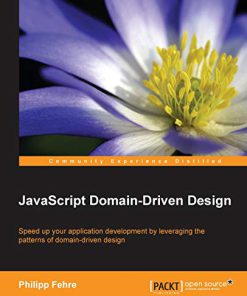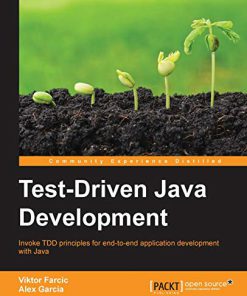Test Driven JavaScript Development 1st Edition by Ravi Kumar Gupta, Hetal Prajapati, Harmeet Singh ISBN 1785288741 9781785288746
$50.00 Original price was: $50.00.$25.00Current price is: $25.00.
Test Driven JavaScript Development 1st Edition by Ravi Kumar Gupta, Hetal Prajapati, Harmeet Singh – Ebook PDF Instant Download/Delivery: 1785288741, 9781785288746
Full download Test Driven JavaScript Development 1st Edition after payment

Product details:
ISBN 10: 1785288741
ISBN 13: 9781785288746
Author: Ravi Kumar Gupta, Hetal Prajapati, Harmeet Singh
Learn JavaScript test-driven development using popular frameworks and tools About This Book • Learn the life cycle of TDD and its importance in real-world application • Gain knowledge about popular tools and analyze features, syntax, and how they help in JavaScript testing • Implement test-driven programming exercises using the practical code examples Who This Book Is For If you have an intermediate knowledge of HTML, CSS, and JavaScript and want to learn how and why the test-driven development approach is better for your assignments, then this book is for you. What You Will Learn • Basic TDD fundamentals, life cycle, and benefits • Become acquainted with the concepts and elements of unit testing and writing basic unit tests for JavaScript • Understand the way JsUnit, Qunit, Karma and DalekJs work • Use the Jasmine framework • Interpret feature detection and devise tests specific to cross-browser compatibility • Integrate jsTestDriver with Eclipse and run tests with jsTestDriver • Explore re-factoring, adding and notifying observers • Understand test-driven development in case of server-side JS In Detail Initially, all processing used to happen on the server-side and simple output was the response to web browsers. Nowadays, there are so many JavaScript frameworks and libraries created that help readers to create charts, animations, simulations, and so on. By the time a project finishes or reaches a stable state, so much JavaScript code has already been written that changing and maintaining it further is tedious. Here comes the importance of automated testing and more specifically, developing all that code in a test-driven environment. Test-driven development is a methodology that makes testing the central part of the design process – before writing code developers decide upon the conditions that code must meet to pass a test. The end goal is to help the readers understand the importance and process of using TDD as a part of development. This book starts with the details about test-driven development, its importance, need, and benefits. Later the book introduces popular tools and frameworks like YUI, Karma, QUnit, DalekJS, JsUnit and goes on to utilize Jasmine, Mocha, Karma for advanced concepts like feature detection, server-side testing, and patterns. We are going to understand, write, and run tests, and further debug our programs. The book concludes with best practices in JavaScript testing. By the end of the book, the readers will know why they should test, how to do it most efficiently, and will have a number of versatile tests (and methods for devising new tests) to get to work immediately. Style and approach Easy-to-follow guide with suitable examples for developing JavaScript code in the test-Driven environment, with popular tools and frameworks. User experience and statements are also included to help readers make a better choice of tool for real-world projects.
Test Driven JavaScript Development 1st Table of contents:
1. Overview of TDD
Complexity of web pages
Understanding test-driven development
The need for testing
Types of testing
The life cycle of TDD
TDD microcycle
Agile and TDD
Benefits of TDD and common myths
Benefits
Myths
Summary
2. Testing Concepts
Unit testing
Unit testing frameworks
YUI Tests
Following the process
Preparing the environment
Following the life cycle
Writing a test
Running the test and seeing if test fails
Writing a production code
Running all tests
Cleaning up the code
Repeat
Using the browser console
setUp() and tearDown()
Test suites
Actions and assertions
Actions
Assertions
Benefits and pitfalls
Benefits of unit testing
Pitfalls of unit testing
Summary
3. Testing Tools
JsUnit
Getting started
Writing tests
Running tests
QUnit
Getting started
Writing tests
Running tests
Karma with Jasmine
Getting started
Writing tests
Running tests
DalekJS
Getting started
Writing tests
Actions
Assertions
Running tests
Summary
4. Jasmine
Understanding behavior-driven development
Setting up Jasmine
describe and specs
Expectations
Matchers
Set up and tear down
Spies
Tracking spies using calls
Creating a custom spy
Jasmine clock
Creating a custom matcher
Creating a custom equality tester
Asynchronous calls
The Jasmine Ajax plugin
Nesting suites
Disabling suites and specs
Summary
5. JsTestDriver
JsTestDriver
Overview
Getting started
Writing tests
Assertions
Capturing the browser
Restructuring your project
The configuration file
Running tests using the command prompt
Setting up JsTestDriver with IDE
Running the tests
Running Jasmine specs
Code coverage
Summary
6. Feature Detection
Understanding feature detection
Available methods and libraries
has.js
Writing custom tests
Modernizr
Downloading and setting up Modernizr
How it works
Using Modernizr
Polyfills
Loading polyfills
Supported browsers
Browser detection
User agent sniffing
Object detection
Features testing with Modernizr
CSS features
HTML5 features
Miscellaneous features
Plugins for additional tests
Modernizr methods
Modernizr.prefixed()
Modernizr.prefixedCSS()
Modernizr.mq()
Modernizr.on()
Modernizr.atRule()
Modernizr.addTest()
Modernizr.testStyles()
Modernizr.testProp()
Modernizr.testAllProps()
Modernizr.hasEvent()
Modernizr._prefixes and Modernizr._domPrefixes
Undetectable features
Summary
7. Observer Design Pattern
Overview
When to use it
Advantages
Disadvantages
Different implementations of the observer
Event dispatcher/listener
Publish/subscribe
Push versus pull
Sample code
Understanding patterns in API
The notify method
Subscribe
Unsubscribe
Observer with topics
Observer pattern using jQuery.Callbacks
Implementing the observer pattern using TDD
Red step (code with error)
Green step (with running code)
Refactoring
Hot swapping components
Browser compatibility of the observer API
Summary
8. Testing with Server-Side JS
Setting up the environment
Installing Node.js
Setting up the application
Choosing a test runner
Mocha and Chai
Server-side unit testing
Implementing the web server
Helpdesk – sample application
Setting up the MongoDB database
The Mocha test
Summary
9. Best Practices
TDD best practices
Follow proper rules to define test cases
Make test case names more readable
Keep the same name for test files and source files
Keep the name descriptive
Applying proper processes
Making sure that tests are written before starting implementation
Modifying/writing new code only when the test is failing
Running all the tests when we modify anything in the existing code
Existing tests should pass before new tests are written
Cleaning up code once all test cases are passed
Follow right development practices
Simple code that can be easily understood
Writing assertions first
One assertion per test is enough
Keep your focus on findability
Reducing duplication
Tests should run fast
Using mocks
Using stubs
Using setUp and tearDown methods
Choosing the right tool
Feature detection tools
Server-side testing tools
Asynchronous testing
Running time of unit tests
Browser support
People also search for Test Driven JavaScript Development 1st:
test driven javascript development
test driven javascript development pdf
test driven development example
test driven development java example
test driven development javascript example
Tags:
Ravi Kumar Gupta,Hetal Prajapati,Harmeet Singh,JavaScript
You may also like…
Computers - Other
Uncategorized
Computers - Programming
Computers - Web Development
Ultimate Selenium WebDriver for Test Automation 1st Edition Robin Gupta
Uncategorized
Computers - Web Development












